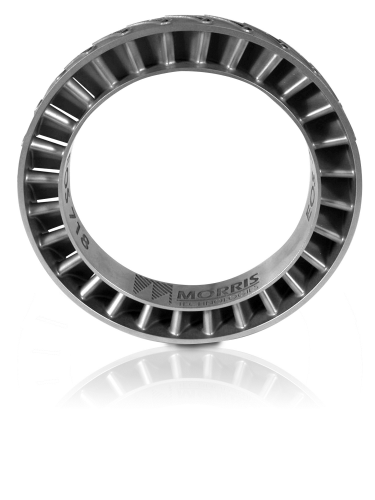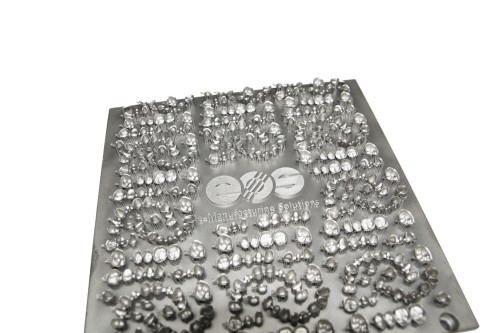

2014, according to many analysts, is going to be “the” year for metal 3D printing. Certainly it has begun well, with industry leader Stratasys, which previously focused only on plastics, moving into the metals arena with its acquisition of Solid Concepts, following 3D System’s purchase of Phenix Systems last year. So it’s important to remember that it was only really 19 years ago that metals additive manufacture was “born” – when metal additive manufacturing specialist EOS moved from liquid phase sintering to develop and patent its direct metal laser sintering (DMLS) technology based on powders in 1995.
“In 1989, the company was a classic family-owned business,” Stuart Jackson, EOS regional manager for the UK and Ireland, told Metal Powder Report. Founded by Dr Hans J Langer and Dr Hans Steinbichler, the latter later sold his shares to Dr Langer, who remains CEO today, while the company is still privately owned. It initially specialised in rapid prototyping and stereolithography, funded by a BMW programme to develop prototype plastic parts. However, this all changed in 1994, when EOS launched the EOSINT M 160, the prototype of a commercial system for EOS’ direct metal laser sintering (DMLS) process, and in 1995 EOSINT M 250 was developed. It carried out the DMLS of metal tools for plastics injection moulding, signalling the start of rapid tooling.
A growing industry
The company soon began to see global success, echoing the exponential growth in 3D printing worldwide. In 2008 EOS reported that in fiscal 2006/2007, the company increased sales by 14%, achieving a worldwide turnover of €59.7 million and registering nearly 50 new customers. Its export rate added up to more than 70%, corresponding to around €42 million. A strong sales driver in 2006/2007 was Central Europe, where EOS exceeded sales expectations by almost 30%.
Two years later, it was reported that more than 40% of global service providers would select EOS, according to the Wohlers Report. “When global service providers were asked which technology they would most likely add, the most popular response was laser sintering from EOS, followed by PolyJet from Objet and FDM from Stratasys,” the company said.
In 2011, EOS reported that it had sold more than 1,000 laser sintering systems worldwide, while in 2014, EOS looked back on a successful 2012/2013 in which turnover increased to €130 million. In the last business year, an additional 70 employees were taken on.
Protecting patents
In 1997 EOS and 3D Systems agreed that the STEREOS stereolithography product line would be sold to 3D Systems, while EOS took over global patent rights for laser sintering technology to focus exclusively on powder based additive, layer-by-layer manufacturing processes. The company took pains to protect its various laser sintering patents, and by 2008 the EOS patent portfolio included more than 50 patent families worldwide. “It’s always the case at the birth of new technology; there is always uncertainty,” says Stuart. “But it was important to us to protect our customers. We licenced out the technology to competitors, and keep up our R&D and new patent applications.”
Although some core patents for selective laser sintering (SLS) technology will expire this year, the company still has many DMLS patents in place.
Dental developments
One important developing sector for EOS is dental components. In 2008, EOS and dental specialist BEGO announced a licence agreement of patents EP 1021997 and US 7,084,370, amongst others. The laser sintering technology enabled the production of dental bridges and crowns layer by layer directly from CAD data, mainly using cobalt-chrome alloy powder. One laser sintering system can produce up to 500 dental units per day; an automated production which can eliminate certain laborious and expensive processes for the dental laboratory, such as casting. The technology thus increases the efficiency of the dental industry and the productivity of dental laboratories.
“The unbeatable advantages of the technology in the dental area are obvious,” said Christoph Weiss, managing director of the BEGO group, at the time. “We look forward to various future synergy effects not only for a joint market development but also with regards to the next advancements of the technology."
In fact, five years later, EOS was able to report that in the interim, about 50 million laser-sintered dental crowns, copings and bridges have been created in over 60 DMLS systems worldwide, at a rate of around 6.8 million per year. In some countries, EOS’ market share for metal (primarily cobalt chrome) dental units is 80 to 100%, with the possibility of laser sintering producing even more dramatic changes to the dental market in the decades ahead.
“Our present product line supporting lost wax is probably going to be obsolete in ten to fifteen years,”claimed Bill Oremus, president of BEGO USA. “The end of casting is approaching as the application of additive manufacturing to dentistry begins to alter the landscape.”
Developing powders
An important side production is the development of powders for EOS machines. In 2009 the company developed titanium alloy powders (EOS Titanium Ti64, which is Ti6Al4V alloy in fine powder form) for its DMLS technology, while promoting the use of titanium in laser sintering. “The conventional methods of casting, forging and machining are often difficult and expensive with titanium materials,” the company said. “And the possibility to easily build hollow and other lightweight structures by laser sintering offers many possibilities to improve the performance and therefore the value of titanium parts in weight-critical applications such as aerospace components.”
Earlier this year, EOS developed Titanium Ti64ELI and EOS StainlessSteel 316L. EOS Titanium Ti64ELI is a light metal alloy that shows an excellent corrosion resistance. Due to its biocompatibility and high grade of purity it is suitable for the additive manufacturing of medical implants. EOS StainlessSteel 316L is a corrosion resistant and biocompatible stainless steel. In the medical industry, this alloy is suitable for surgical instruments, for endoscopic surgery, orthopaedics and implants. The material is also suitable for use in the watch and jewellery industry.
Most recently, it has launched EOS NickelAlloy HX, a heat and corrosion resistant nickel-chrome-iron-molybdenum alloy, suitable for temperatures up to the region of 1,200°C. The material is suitable for processing in the EOSINT M 280 metal system, and is typically processed with a layer-thickness of 20 µm.
Sustainable sintering
The sustainability of 3D printing has always been in question. In 2010, in collaboration with EADS Innovation Works (IW), EOS started work on a study to understand the potential of the DMLS) process to generate savings in the use of energy and raw materials.
A previous study conducted by EADS IW showed that although the use of energy during the manufacturing phase could not compare with conventional manufacturing processes, energy consumption during the use-phase of aircraft components dropped significantly. The DMLS technology can lead to weight reduction of the components, and thus fuel and CO2 emissions reduction.
In parallel, EOS carried out a product carbon footprint (PCF) calculation of one kilogram of sintered material. The findings supported EADS IW’s research, as they showed that the greatest impact on reducing CO2 emissions and energy consumption was to be found during the use-phase of laser-sintered components.
Four years later, EOS collaborated again with EADS Innovation Works (now called Airbus Group Innovations), to complete an environmental lifecycle comparison of rapid investment casting and DMLS.
Comparing the lifecycle of a steel bracket (casting process) with the lifecycle of a design-optimized titanium bracket (DMLS) the organisations found that CO2 emissions over the whole lifecycle of the nacelle hinges could be reduced by nearly 40% via weight saving using the DMLS process and titanium. Most significantly, using DMLS to build the hinge may reduce the weight per plane by 10 kg.
The second phase of the analysis focused on the manufacturing process for the bracket using titanium and found that the total energy consumption for creating the initial raw powder metal, then producing the bracket in DMLS, was slightly smaller than the equivalent cast process steps, with the higher energy use of DMLS limited to the melt and chill cycle of its manufacturing profile and offset at the same time by a significantly reduced build time).
Industrialising the process
In 2005 EOS introduced the ytterbium fibre laser to its systems. This meant that the technology could go into full mount processing allowing the company to increase output and reliability, and starting it on the path to full industrialisation.
The company’s focus is now on developing AM for industrial processes. “EOS is in the process of transforming itself from a manufacturer of systems for prototyping, to a solution provider for additive, industrial series production,” it said in a press release.
“The unique thing about our machines is that, in the main, they are bigger than those of the other players,” says Stuart. “They are used in industrial applications, while many of our competitors are still at the prototyping stage.”
From 2015, EOS is planning to offer in addition to the EOS M 400 the EOS M 400-4, which will have four lasers. “The four laser machine will be used for aerospace super alloy manufacturing,” says Stuart. “Using four individual 400W lasers working simultaneously can produce parts faster and more efficiently.”
Currently, some 28 machines are being used to make aerospace parts, while 60 machines make dental copings for dental crowns. “Our machines made six million pieces last year,” says Stuart. While the company has a global take up, each country has a different main industry. “Tooling for instance is very strong in Germany, but not so much in the UK, where motorsport is a big player. Each country has a strength and demand in each area,” says Stuart.
The size of the machines is equalled by the size of the company. “Without question, by sale of systems, EOS is now the largest laser sintering company in Europe, and for metals tech, in the world,” says Stuart. It currently has around 45-50% of the market share.
The company is building a new purpose-built AM facility in Krailling, outside Munich, Germany, which is planned to be operational in May 2014. The building will feature a “transparent facility” on the ground floor, through which visitors can observe, in action, the complete portfolio of polymer and metal systems offered by the company.
The future
So what is the future for EOS? “We are a tech driven company, so will continue to develop new products for the high end sector,” says Stuart. “We want to be the primary supplier for big OEMs in aerospace and medical sectors. We have no plans to move into the home printing market. Currently our production is about 50/50 plastics and metal, and we will develop technology for both materials.
“Currently, Europe has been at the forefront of scaling up the technology, but the US and Asia are coming up fast behind. Europe is still our biggest market, but others are expanding at a phenomenal rate.”






